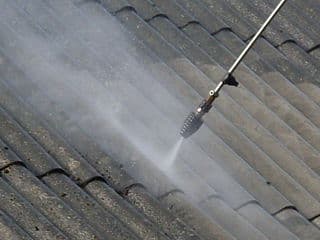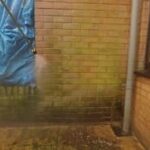As an Amazon Associate, this site earns commissions from qualifying purchases. For more information click here.
Pressure washers are very effective in cleaning large areas quickly. This is why a lot of people use it to wash driveways covered in dirt and grime. Unfortunately, pressure washers can leave marks on cement. The good news is there is a way to fix cement marks left by pressure washers, and even a beginner can do it.
To remove pressure washer marks on concrete, mix 3-4 parts water for every 1 part muriatic acid. Spray this mixture on the affected concrete and scrub it quickly with a brush. Wait for ten minutes then wash it off with a garden hose. Repeat if necessary.
How to Repair Concrete Damage from Pressure Washer
To remove the marks you have to use muriatic acid. Make sure you follow all safety precautions when handling this material.
Required Tools and Materials
- Muriatic acid (Acid Blue by CPDI works pretty well)
- Two buckets
- At least 2 gallons of water
- Baking soda
- Garden lime
- A cup of ammonia
- Masonry brush
- Bottle sprayer
- Protective goggles
- Acid proof gloves
- Dual cartridge respirator (for full protection we suggest the PT-101 Full Face Respirator)
- Acid proof clothing
This must only be done outdoors in a well-ventilated environment. The first thing you should do is to put all the safety gear. Once you are done, you can proceed to the following.
Step 1. Pour 3-4 parts of water into the bucket for every one part muriatic acid. Place baking soda nearby in case some of the acid spills.
For every 45 square feet of concrete marks, you will need a gallon of a water and muriatic acid. Use the 1:4 ratio as given above.
Step 2. Spray the water acid mix onto the marks and quickly brush it off. Brush as much stain as you can. Do this for ten minutes.
Step 3. After ten minutes, wash the water off with a garden hose.
If the marks are gone, you are done. If there are still some remaining, proceed to step 4.
Step 4. Pour a gallon of water into another bucket, not the one you used to mix the muriatic acid. Mix in some garden lime, baking soda and ammonia into the water.
Step 5. Pour this water onto the marks and scrub quickly. Allow it to dry for at least 10 minutes. Try to get rid of as much of the stains as you can.
Step 6. Rinse the cement again with the garden hose. Repeat as often as required to get rid of the marks. Never use a pressure washer to remove the marks because it will just make it worse.
Other Ways to Remove Pressure Washer Cement Marks
Pressure washers can leave all kinds of debris on cement. There are many ways to deal with them apart from using muriatic acid and water. Here are other options.
Keep washing. Sometimes it is easy to mistake dirty areas for marks. You may have cleaned the cement unevenly so there appears to be discoloration. Examine the surface closely and if it is just dirt, keep washing until the color becomes similar.
Sanding. If the mark goes deep into the cement, washing with acid is not going to be enough. The best option is to sand out the marks and paint it if necessary. How much sanding is needed will depend on the extent of the damage.
Garden hose. If there are just a few debris, wash it off with a garden hose. You can also try the pressure washer again but use a larger nozzle. A slow spray with little pressure should be enough.
Slow down. If you notice marks appearing, slow down your spraying. The faster you spray the more pressure goes into the cement.
Use smaller a muzzle. Earlier we pointed out you should only use a garden hose to remove cement marks. But if you prefer a pressure washer to spray the muriatic acid, a smaller nozzle is ideal.
Grease, oil and built up grime can be hard to remove. If you do not want to add more pressure, move the washer closer. If you are standing 10 feet away, move a couple of feet closer.
Leave light marks. If the marks a very light, they might disappear over time. If the surface gets a lot of use, the marks will be covered by dirt soon enough. In some cases the marks will simply blend in.
Painting the surface. If the concrete has a finish, you have to repaint it. This can be difficult to do if there are two or more colors. In these cases you are better off calling an expert to do the paint job.

Can You Ruin Concrete with a Pressure Washer?
It is possible to damage concrete or cement surfaces with a pressure washer. This can occur if you apply too much pressure. Even a light duty pressure or power washer can cause permanent damage.
The reasons why this might happen are:
Too much pressure. Using a heavy duty pressure washer on weak cement can ruin the surface. Poorly made concrete is prone to markings, lines and other damage. Too much pressure can remove the mortar and further ruin the cement.
Weak concrete. If the cement is less than a year old, it might not have solidified enough to handle power washing. Similarly, old cement will be more vulnerable to this kind of force.
Spraying very near the surface. Stand 10 feet from the surface you want to wash, and keep the nozzle at least 6 inches above the surface. This is important particularly if the cement is old. Even new concrete surfaces will get marks if you wash too close to it.
Using the wrong cleaning solution. Use muriatic acid only if it has been diluted as instructed here. Pure acid is going to permanently destroy the concrete.
Wrong nozzle. Use wide nozzles when pressure washing cement. Narrow nozzles put too much pressure on the surface. Remember that pressure washers are much more powerful than garden hoses, so only a small amount of power is needed.
Spraying on one spot too long. Once the spot is clean, move on to the next. If the dirt will not come off, come back to it later. If the mark is too deep, sanding might be the only option left as no amount of washing can fix it.
How to Prevent Pressure Washers from Damaging Cement
The good news is that concrete marks are usually easy to fix. Even better, you can prevent it by following these simple tips.
Set the pressure washer to the appropriate configuration and then choose the precise spot you want to clean. Aim the spray high and move it one direction.
Always read the operating instructions. Your pressure washer comes with a guide on how to wash different surfaces including concrete. This will save you a lot of time and trouble. This applies not just to pressure washing cement but also fixing pumps.
Use the proper nozzle. In most cases a 25 degree nozzle is ideal. Never use zero degree nozzles, and 15 degree nozzles are best used for iron materials. The higher the degree, the less pressure is applied to the surface. If you want to be really safe, use a 65 degree nozzle.
Wash from a distance. The nozzle should be at least 6 -12 inches from the concrete surface you are cleaning. Move a little closer if the dirt refuses to come off.
Aim high. Adjust the pressure washer setting to 3000 psi and focus the spray higher than your intended surface target.
If there is a lot of dirt on the concrete, work one area at a time. Try to maintain the same distance at all times so the surface ends up with a consistent look.
No pressure washing on new cement. If your driveway has just been cemented, wait at least 12 months before pressure or power washing. These washers are up to 50 times more powerful than a hose and can damage newly made cement.
Wash yearly. Concrete only needs to be pressure washed once a year, maybe ev ry six months if it gets really dirty. But do not wash every week or every month because that will lead to permanent damage.

I love the outdoors and all the tools for maintaining gardens, yards and lawns. The only thing I am more passionate about is sharing what I know about garden and outdoor equipment.


